

Moving Beyond the Five-Paragraph Essay: Expand the Possibilities of the Genres You Teach. Moving Beyond the Five-Paragraph Essay: Expand the Possibilities of the Genres You Teach My Understanding of Essay, Then… I did my student teaching in a classroom where all students were handed a hamburger graphic organizer and were taught to fill in all parts of the burger if they wanted to create a “good essay.”
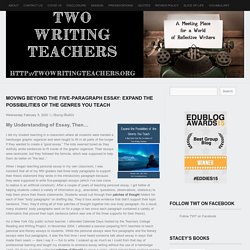
The kids seemed bored as they dutifully wrote sentences to fit inside of the graphic organizer. Their essays were lackluster, but they followed the formula, which was supposed to help them do better on “the test..” The Curse of "Helicopter Teaching" Five Ways to Spend Less Time With Papers This Year (Without Sacrificing Your Impact) – Matthew M. Johnson. Last week I tweeted out a simple question in preparation for this post: How many students do you have on your student load for ’19-’20?
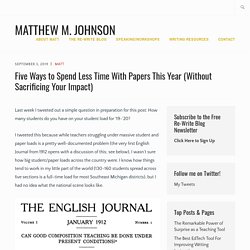
I tweeted this because while teachers struggling under massive student and paper loads is a pretty well-documented problem (the very first English Journal from 1912 opens with a discussion of this; see below), I wasn’t sure how big student/paper loads across the country were. I know how things tend to work in my little part of the world (130-160 students spread across five sections is a full-time load for most Southeast Michigan districts), but I had no idea what the national scene looks like. Revision: Take It One Step at a Time. Turn Feedback into Progress. Rehashing - What It Is and How It Works. When I was a newer AP Lit teacher I attended a one-day AP training, as many teachers do.
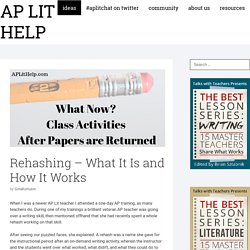
During one of my trainings a brilliant veteran AP teacher was going over a writing skill, then mentioned offhand that she had recently spent a whole rehash working on that skill. After seeing our puzzled faces, she explained. A rehash was a name she gave for the instructional period after an on-demand writing activity, wherein the instructor and the students went over what worked, what didn’t, and what they could do to improve. When Students Need Structure: Utilizing Graphic Organizers.
By Erika Watts “But I don’t know what to write,” the student says in frustration, looking at the blank paper ahead.
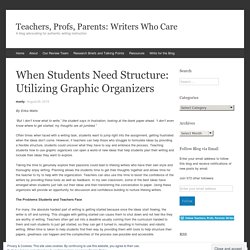
“I don’t even know where to get started; my thoughts are all jumbled.” Often times when faced with a writing task, students want to jump right into the assignment, getting frustrated when the ideas don’t come. However, if teachers can help those who struggle to formulate ideas by providing a flexible structure, students could uncover what they have to say and embrace the process.
WriteOut Foundation (@WriteOutCamp) A Life Full of Revision. I saw one in early August this year, winging its way over our Fine Line Buckthorns, past our Red Maple tree, through our verdant yard.
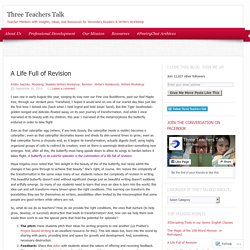
Transfixed, I hoped it would land on one of our scarlet day lilies just like the first time I beheld one (back when I held Ingrid and held Jonas’ hand). But this Tiger Swallowtail–golden-winged and delicate–floated away, on its own journey of transformation. And while I once marveled at its beauty with my children, this year I marveled at the metamorphosis the butterfly endured in order to take flight.
Even as that caterpillar egg (where, if you look closely, the caterpillar inside is visible) becomes a caterpillar; even as that caterpillar decimates leaves and sheds its skin several times to grow; even as that caterpillar forms a chrysalis and, as it begins its transformation, actually digests itself, using highly organized groups of cells to redirect its creation; even as there is seemingly destruction–something new emerges. Good Sentences Are Why We Read.
No one can agree on what a sentence is.

The safest definition is typographic. A sentence starts with a capital letter and ends with a full stop—except that some start with quote marks, and some end with question or exclamation marks, so that doesn’t quite work. Let’s try again. A sentence is the largest domain over which the rules of grammar have dominion. Revising for Meaning. My colleagues laid our papers down on the table in front of us.
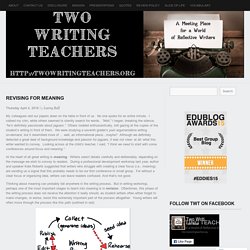
No one spoke for an entire minute. I rubbed my chin, while others seemed to silently search for words. “Well,” I began, breaking the silence, “he’s definitely passionate about jaguars.” Others nodded enthusiastically, still gazing at the copies of the student’s writing in front of them. We were studying a seventh grader’s post argumentative writing on-demand, but it resembled more of … well, an informational piece…maybe? At the heart of all great writing is meaning. Thinking about meaning can probably fall anywhere in the writing process. Young writers often bypass revision, or only give it cursory attention. One of the greatest gifts we can give our writers is teaching the value of revision. However, revision is not easy. One way we can teaching into this is by teaching students to revise in service of meaning. Revising for Meaning “Maybe what I’m trying to say is . . .” Four Ways to Revise with Meaning in Mind.
How to Use Short Writing Assignments. Take That, AP Style! Court of Law Rules The Oxford Comma Necessary. Helpful tool: If you need a grammar checker for your writing, try ProWritingAid.
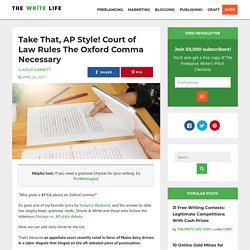
“Who gives a $#%& about an Oxford comma?” So goes one of my favorite lyrics by Vampire Weekend, and the answer to date has largely been: grammar nerds, Strunk & White and those who follow the infamous Chicago vs. AP style debate. Now, we can add dairy driver to the list. Bridging the Writing Gap: Centering Student Voices in High School and College Writing. By Kristen Marakoff and P.L. Thomas Kristen Marakoff’s journey to becoming a high school English teacher began 7 years ago in Paul Thomas’ foundations course. She completed the certification program at Paul’s university, where he taught English Language Arts teaching methods and supervised her field work. Paul also teaches first-year writing—after teaching high school English throughout the 1980s and 1990s. 20 Ways to Cut Your Grading Time in Half. Developing Students' Ability to Give and Take Effective Feedback.
Training kids to give effective critique is one of those teaching strategies that takes some time on the front end, but can save a lot of time once students get good at it. It’s common for students to give unhelpful, general or unkind feedback that doesn’t do much to advance a peer’s goals for the work, but Lukas found when she carefully trained students on some conversational “commandments” and attitudes around peer critique, 12-year-olds could give feedback as well as any adult. Even better, when kids got feedback from peers, she found they internalized it more. But incorporating peer critique into the classroom does take time, which is most effectively spent on bigger, meatier projects that students are invested in improving. Lukas advises teachers she works with to use the adapted Six Hat feedback strategy only on assignments that require students to do several drafts, so they have time to incorporate the feedback they received.
Pick work that matters. Bullock's Rules for Writing. College Essay Guy - College Application and Essay Help. How to Write a Winning College Essay — ArgueLab. Write a Winning College Essay 'Tis the season of essay-writing misery!

I posted this some years ago, and it continues to be among the most popular pieces I've ever written. As someone who writes a lot about persuasion, I’m frequently asked by high school juniors and their parents how to write a successful college essay. My own son, George, sought my advice, and he was glad he did. His essay about a headache (yes, a headache), helped get him into his highly selective first-choice school, Middlebury College. It did the job, though. 1.
While the top schools look for good writing, they’re more interested in character. Five Myths About Teaching Writing.
The Difference Between Storytelling and Band-Aids. When I was in graduate school, I was lucky enough to take a lot of classes with Lucy Calkins, who would become my mentor, advisor, boss, and guide for more than a decade of my professional life.

I remember an aha moment during one of my first classes with her when I realized that there was a difference between narrative storytelling–and summarizing. That night, Lucy used the book Shortcut by Donald Crews as an example of a “small moment” that had been told in great detail, stretched out bit by bit. Wrapping Up: A Look at Conclusions in the Workshop. What do you think is the hardest part about teaching writing? I’ve always had strong lessons on introductions and felt confident in supporting writers to explore genre and style. But, man, teaching emerging writers how to close a piece…that has always felt extra hard.
Enhancing Student Writing: Framing Editing as Choice. Reader Idea: A New Research and Argument-Writing Approach Helps Students Break Out of the Echo Chamber. A Friendly Resource for Revising and Editing. The current version of my instructional practices, philosophies, and beliefs was born a couple of years ago. Word spread that our new curriculum coordinator was a “workshop” guy and, coincidentally, I was in a place where change was on my mind. Traditional “drill and kill” methods heavily supplemented with canonical whole class novels and their hip-tied reading guides left me unfulfilled in my “teacher feels” and I knew there had to be a better way. Serendipity through reader’s/writer’s workshop… Much of the credit for the strengthening of my instructional practice can be attributed to the people I’ve met who provided me the opportunity to explore and improve my craft.
Co-Creating Criteria with Students. The ISR Handbook to Giving Effective Feedback. How Emily Dickinson Writes A Poem. Rethinking Revision: The Real Work of Writing. By Ruth Culham Children don’t hate to write; they hate how we teach writing. Some of the most deeply embedded methods of teaching writing – worksheets, canned prompts, and formulas, for example – drain all of the energy and desire required to write well. Our classrooms should be places of inquiry, joy, trial and error, exploration, success and failure, and fascinations revealed—where the process of discovery matters as much as (if not more than) the destination. In my new book from Stenhouse, Teach Writing Well, my goal throughout is to demystify how to teach revision, which is arguably the trickiest part of being a writing teacher.
I’ve focused on what we do to invite revision and make it doable for students and teachers alike—from detailed and on-the-spot assessment to purposeful, meaningful instruction. Give Students Voice with Real-World Argument Writing - Spark Creativity. It can be hard for students to understand the point of writing papers. 9 Books on Reading and Writing. Writing Rubrics That Give You Back Your Weekends - David Rickert. WriQ Introduction and Tutorial. Grading Tools for Google Docs. A Google Docs Add-on That Tells You if Students Read Your Feedback. Oregon Writing Project. The ELA Teacher's Quick Guide to Meaningful Peer Feedback - Spark Creativity. Peer editing can be sooo helpful, or kind of a waste of time. In an ideal world, kids trade their writing, get great help, become better writers, and turn in a final product that is more meaningful. They learn more, and you can spend your marking time writing about their big ideas instead of explaining how to analyze a quotation for the three thousandth time.
But without some guidance, peer editing isn't like this. Students Want to Write Well; We Don’t Let Them. Write More Grade Less - Google Slides.